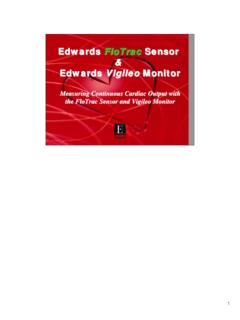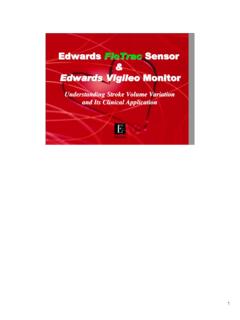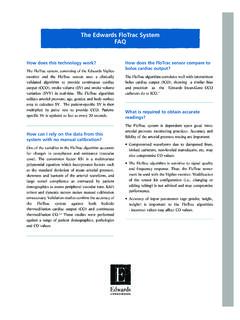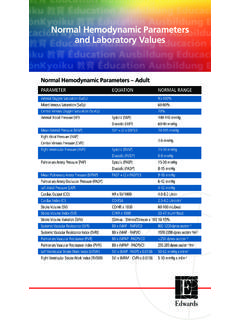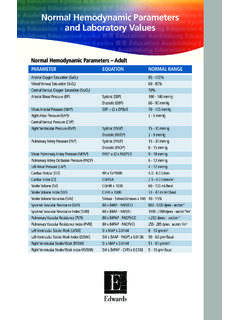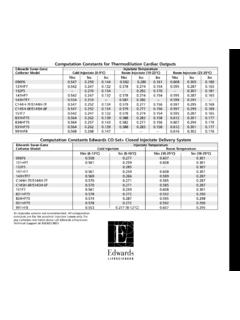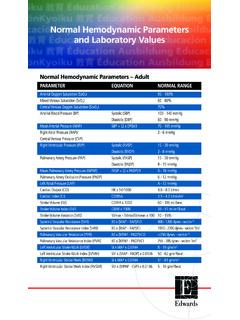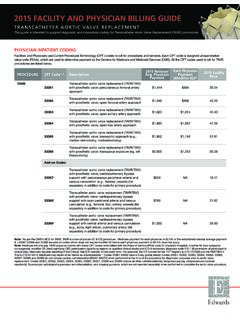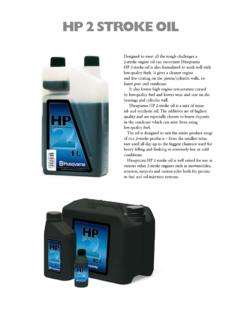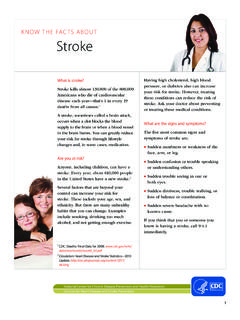Transcription of Stroke Volume Variation “Can We Use Fluid to Improve ...
1 What Causes Stroke Volume Variation ? Stroke Volume Variation is a naturally occurring phenomenon in which the arterial pulse pressure falls duringinspiration and rises during expiration due to changes in intra-thoracic pressure secondary to negative pressureventilation (spontaneously breathing). Variations over 10mmHg have been referred to as pulsus paradoxus. Thenormal range of Variation in spontaneously breathingpatients has been reported between pulsus paradoxus is the same phenomenon withcontrolled mechanical ventilation, however, in pressure rises during inspiration and falls duringexpiration due to changes in intra-thoracic pressuresecondary to positive pressure ventilation.
2 In addition toreverse pulsus paradoxus, it has also been referred to asparadoxical pulsus, respiratory paradox, systolic pressurevariation and pulse pressure Variation . Traditionally SVV iscalculated by taking the SVmax - SVmin / SV mean over arespiratory cycle or other period of and Assessing Fluid ResponseSVV and its comparable measurement, pulse pressurevariation (PPV), are not indicators of actual preload but ofrelative preload responsiveness. SVV has been shown tohave a very high sensitivity and specificity when compared to traditional indicators ofvolume status (HR, MAP, CVP, PAD, PAOP), and their ability to determine fluidresponsiveness.
3 The following table of studiesdemonstrates SVV sensitivity and specificity inpredicting Fluid responsiveness against aspecified infused Volume and defined criteriafor a Fluid Volume Variation Can We Use Fluid to Improve Hemodynamics? Introduction:In the quest to achieve optimal oxygen delivery (DO2), clinicians are often forced to use imprecise, non-specificinformation to guide their therapy. Traditional hemodynamic monitoring parameters (HR, MAP, CVP, and PAOP) are often insensitive and sometimes misleading in the assessment of circulating blood Volume . However, theappropriateness of their interventions is often crucial to avoid the deleterious effects of over-, under-, orinappropriate resuscitation.
4 Volume is one of the first therapeutic interventions selected when optimizing times the choice to intervene using Fluid is accompanied by the difficult questions, Can using Fluid improvehemodynamics? and, Is it the appropriate intervention? Stroke Volume Variation (SVV) as available on the FloTracsystem may help answer these Can I Use SVV?Normal SVV values are less than 10-15% on controlled mechanical ventilation. Thefigures to the right demonstrate using SVV as a guide for Volume resuscitation witha goal SVV of <13%. SVV increased to 19% with a Stroke Volume (SV) of 43 ml/beat,blood and saline were given to obtain a SVV of 6% and a SV of 58 are the Limitations and Effects of Other Therapies on SVV?
5 Mechanical VentilationCurrently, literature supports the use of SVV only on patients who are 100% mechanically (control mode) ventilated with tidal volumes of more than 8cc/kg and fixed respiratory rates. Spontaneous VentilationCurrently, literature does not support the use of SVV with patients who are spontaneously breathing due to the irregular nature of rate and tidal volumes. ArrhythmiasArrhythmias can dramatically affect SVV values. Thus, the utility of SVV as a guide for Volume resuscitation is greatest in absence of arrhythmias. PEEPI ncreasing levels of positive end expiratory pressure (PEEP) may cause an increase in SVV, the effects of which may be corrected by additional Volume resuscitation if warranted.
6 Vascular ToneThe effects of vasodilatation therapy may increase SVV and should be considered before treatment with additional used within its limitations SVV is a sensitive tool that can be used to guide the appropriate management of thepatient s preload to achieve optimal DO2and answer the question Can we use Fluid to Improve hemodynamics? SVV isan available parameter with the FloTrac sensor and the Vigileo VolumeParametersR2 Def. ofSensitivitySpecificityml/KgTested (Artery)ResponderMichard2 Sepsis500 ml8 to 12 PP (R or F) CO 15%9496 Berkenstadt, et Surgery100 ml10 SV 5% 7993 Reuter, et x BMI10 SV 5%7985Rx only. See instructions for use for full prescribing Lifesciences devices placed on the European market meeting the essentialrequirements referred to in Article 3 of the Medical Device Directive 93/42/EEC bear the CE marking of conformity.
7 Edwards and Vigileo are trademarks of Edwards Lifesciences Corporation. EdwardsLifesciences and the stylized E logo and FloTrac, are trademarks of Edwards LifesciencesCorporation and are registered in the United States Patent and Trademark Office. 2007 Edwards Lifesciences LLCAll rights reserved. AR02897 Edwards Lifesciences LLC One Edwards Way Irvine, CA 92614 USA Lifesciences (Canada) Inc. 1290 Central Pkwy West, Suite 300 Mississauga, Ontario Canada L5C 4R3 Phone Lifesciences Ch. du Glapin 6 1162 Saint-Prex Switzerland Phone Lifesciences Japan 2-8 Rokubancho Chiyoda-ku, Tokyo 102-0085 Japan Phone Berkenstadt H, et al.
8 Stroke Volume Variation as a predictor of Fluid responsiveness in patients undergoing brain surgery. Anesth Analg 2001;92 Michard F. Changes in arterial pressure during mechanical ventilation. Anesthesiology 2005; 103 Reuter DA, et al. Usefulness of left ventricular Stroke Volume Variation to assess Fluid responsiveness in patients with reduced cardiac function. Crit. Care Med 2003; 31:1300-404.*Continuous SVR requires CVP to be supplied to Vigileo monitor from a bedside by: J. Frazier RN, RRT, Clinical Marketing, Edwards Lifesciences
